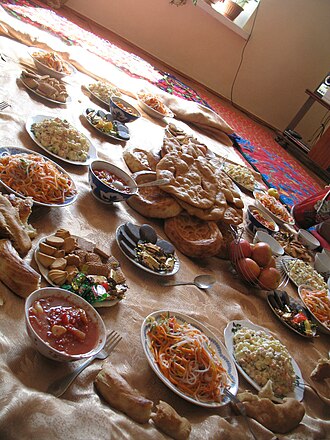Central Asian cuisine




Central Asian cuisine is a type of cuisine that originates from the Central Asian region. This cuisine is influenced by the local agriculture, as well as the nomadic lifestyle of the people in this region. The main staples of Central Asian cuisine include meat, grain, and dairy products.
History[edit]
The history of Central Asian cuisine dates back to the nomadic tribes that inhabited the region. These tribes relied heavily on livestock for their food, which is why meat is a significant part of the cuisine. Over time, the cuisine has evolved and been influenced by the various cultures and civilizations that have come into contact with the region.
Ingredients[edit]
Central Asian cuisine is known for its use of fresh, local ingredients. The most common ingredients used in Central Asian cuisine include:
- Meat: Lamb is the most commonly used meat, followed by beef and chicken. Horse meat is also used in some dishes.
- Grains: Rice, wheat, and barley are the main grains used in Central Asian cuisine.
- Dairy products: Milk, cheese, and yogurt are commonly used in many dishes.
- Vegetables: Onions, carrots, and peppers are commonly used vegetables.
- Spices: Coriander, cumin, and chili peppers are commonly used spices.
Dishes[edit]
Some of the most popular dishes in Central Asian cuisine include:
- Plov: A rice dish cooked with meat, carrots, and onions.
- Manti: A type of dumpling filled with meat or vegetables.
- Shashlik: A type of kebab made with marinated meat.
- Beshbarmak: A dish made with boiled meat and served over pasta or rice.
See also[edit]
- List of Asian cuisines
- Bukharan Jewish cuisine
- Kazakh cuisine
- Koryo-saram cuisine
- Kyrgyz cuisine
- Soviet cuisine
- Tajik cuisine
- Turkmen cuisine
- Uzbek cuisine
Ad. Transform your life with W8MD's Budget GLP-1 injections from $75


W8MD offers a medical weight loss program to lose weight in Philadelphia. Our physician-supervised medical weight loss provides:
- Weight loss injections in NYC (generic and brand names):
- Zepbound / Mounjaro, Wegovy / Ozempic, Saxenda
- Most insurances accepted or discounted self-pay rates. We will obtain insurance prior authorizations if needed.
- Generic GLP1 weight loss injections from $75 for the starting dose.
- Also offer prescription weight loss medications including Phentermine, Qsymia, Diethylpropion, Contrave etc.
NYC weight loss doctor appointmentsNYC weight loss doctor appointments
Start your NYC weight loss journey today at our NYC medical weight loss and Philadelphia medical weight loss clinics.
- Call 718-946-5500 to lose weight in NYC or for medical weight loss in Philadelphia 215-676-2334.
- Tags:NYC medical weight loss, Philadelphia lose weight Zepbound NYC, Budget GLP1 weight loss injections, Wegovy Philadelphia, Wegovy NYC, Philadelphia medical weight loss, Brookly weight loss and Wegovy NYC
|
WikiMD's Wellness Encyclopedia |
| Let Food Be Thy Medicine Medicine Thy Food - Hippocrates |
Medical Disclaimer: WikiMD is not a substitute for professional medical advice. The information on WikiMD is provided as an information resource only, may be incorrect, outdated or misleading, and is not to be used or relied on for any diagnostic or treatment purposes. Please consult your health care provider before making any healthcare decisions or for guidance about a specific medical condition. WikiMD expressly disclaims responsibility, and shall have no liability, for any damages, loss, injury, or liability whatsoever suffered as a result of your reliance on the information contained in this site. By visiting this site you agree to the foregoing terms and conditions, which may from time to time be changed or supplemented by WikiMD. If you do not agree to the foregoing terms and conditions, you should not enter or use this site. See full disclaimer.
Credits:Most images are courtesy of Wikimedia commons, and templates, categories Wikipedia, licensed under CC BY SA or similar.
Translate this page: - East Asian
中文,
日本,
한국어,
South Asian
हिन्दी,
தமிழ்,
తెలుగు,
Urdu,
ಕನ್ನಡ,
Southeast Asian
Indonesian,
Vietnamese,
Thai,
မြန်မာဘာသာ,
বাংলা
European
español,
Deutsch,
français,
Greek,
português do Brasil,
polski,
română,
русский,
Nederlands,
norsk,
svenska,
suomi,
Italian
Middle Eastern & African
عربى,
Turkish,
Persian,
Hebrew,
Afrikaans,
isiZulu,
Kiswahili,
Other
Bulgarian,
Hungarian,
Czech,
Swedish,
മലയാളം,
मराठी,
ਪੰਜਾਬੀ,
ગુજરાતી,
Portuguese,
Ukrainian
